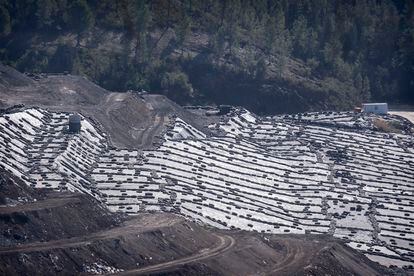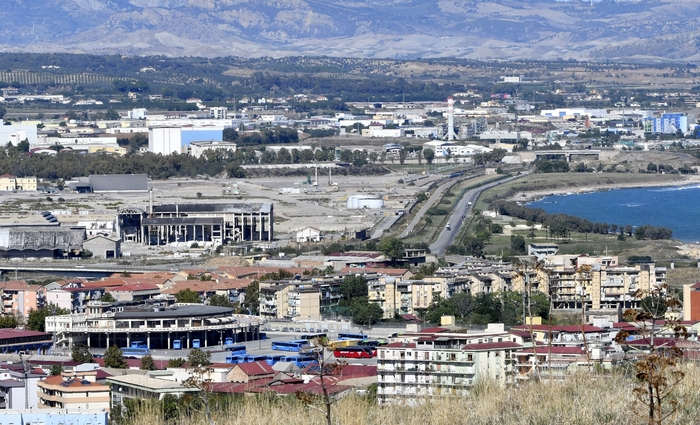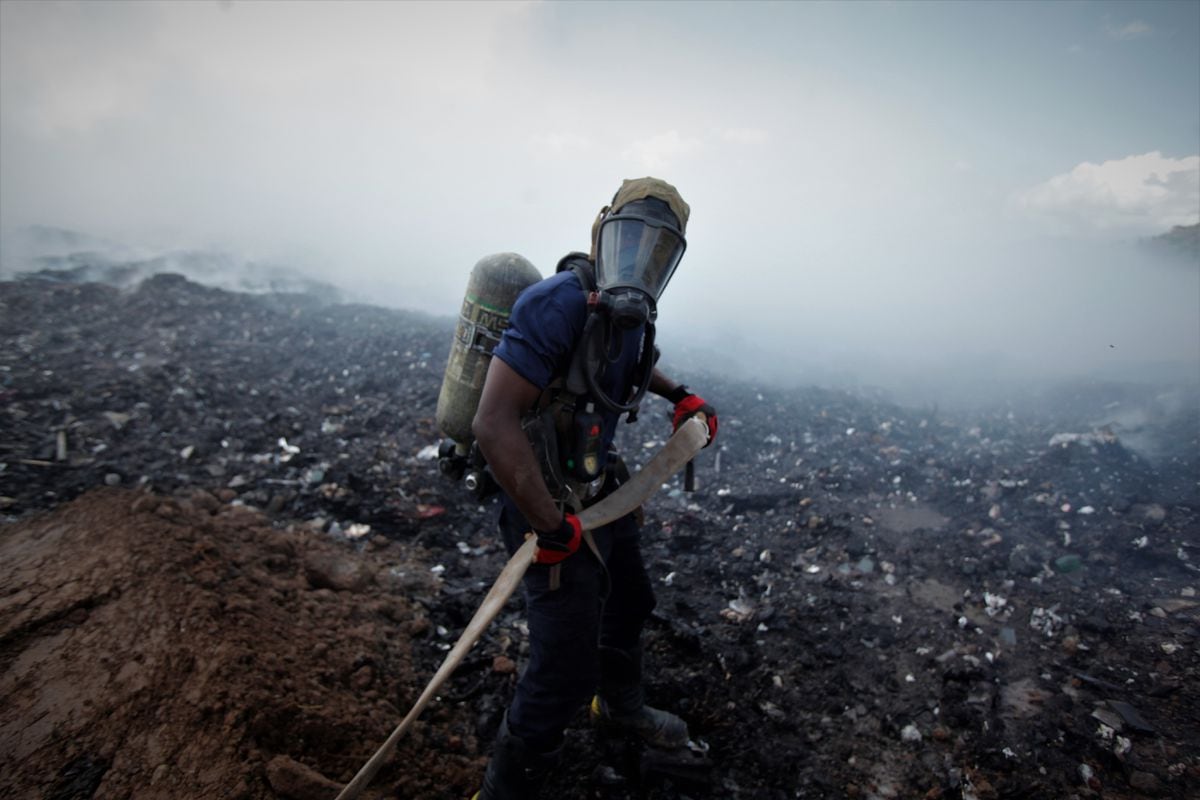Just after a sharp curve, 500 trucks loaded with 25 tons of shot - a dangerous industrial waste with a sandy volume - have crossed this week the bridge over the Guadiamar river, the heart of the ecological corridor between the Sierras de Sevilla and Huelva.
The mayors, environmentalists and residents of the area hold their breath so that an accident does not affect the channel that belongs to the Natura 2000 Network on this winding road and brings to mind the Aznalcóllar disaster, whose toxic sludge flooded the river 24 years ago .
The transfer of bulk hazardous waste from the Bijela shipyard in Montenegro to the port of Seville after traveling more than 3,300 kilometers by boat from the Adriatic Sea, and its subsequent transfer by truck to the Nerva landfill (Huelva), has highlights the intense traffic of all kinds of substances to Spain, a country that receives much more waste than it exports.
The Muzaffer Bey
and
Dakota
ships
were followed this Monday by the
Shannon River
with 6,000 tons, although the Ministry for Ecological Transition has stopped the transfer of industrial waste from the Balkan country for the time being and the 40,000 tons pending transfer are in the air for alleged irregularities found in the
Dakota
.
"We can't go over 70 kilometers per hour and this is all sealed," shouts from his cab a trucker who refuses to give more details, such as the following five carriers asked, and who pass every five minutes through a roundabout on the road .
The trucks display a small sign with a dead fish, which indicates the dangerousness of the cargo, and the tailgate of some leaves a large hole open to the shot.
A manager of a transport company contracted for the transfer plays down the environmental risk: “In the port of Huelva [next to which there is a chemical pole] we load sludge with hydrocarbons twice as dangerous as shot.
He is being given a hype that he does not have, ”he says under anonymity.
International waste traffic is legal and in 2019 Spain received 923,299 tons, nine times more than the 101,077 tons it exported, according to data from the annual report that the Ministry for Ecological Transition refers to the Basel Convention, signed by Spain in 1989 These 923,299 tons include the 38,492 tons of the first shipment of shot from Montenegro and 15,239 tons of lead/acid batteries from Italy.
Meanwhile, to the transalpine country Spain exported 11,282 tons of hazardous solid waste from gas treatment.
Several trucks load industrial waste from Montenegro in the Port of Seville. PACO PUENTES
In 2018, waste traveled to Spain from countries as diverse as Panama, Israel, Uruguay, South Africa or Australia, which exported 6,000 tons of lead to here.
Substances enter through the ports to the plants, where recovery operations are carried out —including incineration to produce energy— or burial with or without prior treatment.
The reasons that make Spain attractive for storing international waste are that it has numerous landfills and plants to receive waste, it has a low population density, an industry that is less powerful than its European neighbors and therefore generates less waste, and competitive prices that they attract foreign companies, forced to give an orderly exit to their waste, illustrate experts in the sector.
International waste traffic is a controversial activity because it breaks the principle of proximity to minimize ecological risks, often because the economic criterion prevails, but also because sometimes it is the only way to achieve a safe destination for toxic substances that damage the environment. , argue the businessmen of the sector.
Storing a ton of hazardous waste underground can cost 80 euros and if treatment is required, the price rises to 100 euros in plants whose conservation lasts for decades.
Hazardous waste is the most expensive to manage but there is hardly any public intervention, contrary to what happens with urban waste.
The market rules and therefore the maximum benefit: Asturias is the only exception with its public plant Cogersa.
“Ideally, they would all be public facilities because, in addition, the Administrations generate abundant hazardous waste from civil works or sewage treatment plants.
There is an international network of waste transfer outside environmental issues, it makes no sense to take waste to Germany or Africa, due to the carbon footprint and environmental costs”, illustrates Fernando Calvo, doctorate in landfills from the University of Granada and director of projects of the firm Proma.
Hills with waste buried in the Nerva landfill, covered with plastic and tires. PACO PUENTES
In the case of the Nerva landfill, the French multinational Valgo won a contest of millions from the Government of Montenegro and chose the people of Huelva for the bulk of its waste, although it also sent smaller volumes of waste to Austria, Greece, Portugal and Norway.
“The shot taken to Spain has been diabolized, it does not have asbestos and its level of toxicity is low, only due to chrome, and it does not cause respiratory problems in people.
You never want to receive waste, but in a global world landfills have to exist.
50 years ago, Spain also exported a lot because there were no facilities,” says José Dos Santos, Director of International Development at Valgo, responsible for the environmental cleanup of the Bijela shipyard.
“The Balkans did not offer a technical or security level,
Italy lacked the necessary certifications and we studied France, but for economic reasons we decided to send them to Nerva.
Moving waste from one place to another is more positive than making illegal landfills”, argues the manager.
In Spain there are fifty final installations for hazardous waste treatment distributed throughout the territory and thousands for non-hazardous waste, according to calculations by the national association of waste management companies, Asegre.
The Ministry for the Ecological Transition refuses to give an official figure and location and alleges that the registration of these plants will be public later, but does not specify a date.
The discharges are deposited in the vessels of the authorized plants and with a drainage system and pipes, the leachate is diverted to the ponds in a complex process.
“Spain has the capacity to treat waste and we offer environmental quality to do it in safe conditions, there should be no rejection.
It has to be seen as something that generates wealth, not as something negative”, defends Luis Palomino, general secretary of Asegre.
On the opposite side, Juan Romero, from Ecologists in Action, criticizes the fact that the principle of geographical proximity is ignored "by system", as with the 3,000 kilometers that separate Bijela from Nerva: "The chemical
lobby
has made a business out of waste and they send them to landfills because they do not want to pay for proper waste management, they have commercialized them.
What you have to do is minimize the generation of waste and reuse or make it inert.
The problem?
The industry does not want the value of the waste to affect its own benefits and that is why it sends it to landfills”.
In the transition planned by the Government towards the circular economy, recovery and recovery treatments will increase and the new waste law plans to reduce the deposit of hazardous substances in landfills thanks to a specific fee to encourage that they are not dumped.
"Batteries are buried and can be recovered, only treatment costs are high," exemplifies Calvo.
The DSM company wants to prolong the life of the Nerva plant (5,300 inhabitants) for another decade in the face of opposition from the mayor, neighbors and environmentalists, while the Andalusian Board has avoided responding to its proposal for almost two years.
The City Council opposes: "I ask the Andalusian Board to carry out inspections of the facilities in an unscheduled manner, which should stir the consciences of its leaders," complains the mayor, José Antonio Ayala.
When the trucks unload at the landfill, the smoke can be seen from the neighborhood of El Ventoso, just 700 meters from the facility.
Elena González is worried about the possible effects on the health of her parents, who were born here 65 years ago.
“The windows cannot be opened because the smell of rotten eggs comes in waves during the day.
Now my mother takes the opportunity to hang out when there are no trucks, but in the summer it is exaggerated, day and night”.
A lady walks in the neighborhood of Ventoso de Nerva, with the landfill in the background.
PACO PUENTES (THE COUNTRY)
You can follow CLIMA Y MEDIO AMBIENTE on
and
, or sign up here to receive
our weekly newsletter
Exclusive content for subscribers
read without limits
subscribe
I'm already a subscriber












/cloudfront-eu-central-1.images.arcpublishing.com/prisa/KMEYMJKESBAZBE4MRBAM4TGHIQ.jpg)


